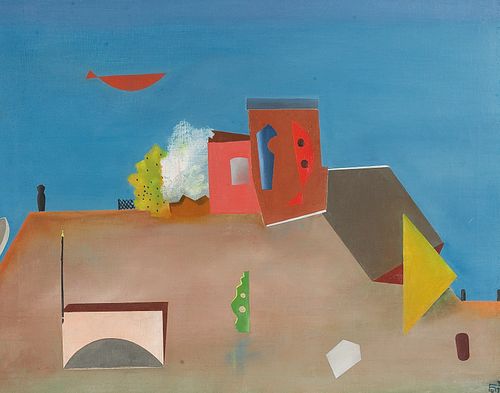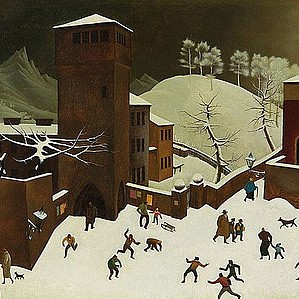OTTO HOFMANN (Essen 1907 - 1996 Pompeiana) House by a Lake, 1933
Lot 153
Estimate:
EUR€5,000 - EUR€8,000
$5,434.78 - $8,695.65
Absentee vs Live bid
Two ways to bid:
- Leave a max absentee bid and the platform will bid on your behalf up to your maximum bid during the live auction.
- Bid live during the auction and your bids will be submitted real-time to the auctioneer.
Bid Increments
| Price | Bid Increment |
|---|---|
| EUR€0 | EUR€10 |
| EUR€100 | EUR€50 |
| EUR€700 | EUR€100 |
| EUR€1,000 | EUR€200 |
| EUR€3,000 | EUR€300 |
| EUR€3,600 | EUR€400 |
| EUR€4,000 | EUR€500 |
| EUR€7,000 | EUR€1,000 |
| EUR€16,000 | EUR€2,000 |
| EUR€30,000 | EUR€3,000 |
| EUR€36,000 | EUR€4,000 |
| EUR€40,000 | EUR€5,000 |
About Auction
By Widder Auctions
May 19, 2022
Set Reminder
2022-05-19 11:00:00
2022-05-19 11:00:00
America/New_York
Bidsquare
Bidsquare : Masterpieces
https://www.bidsquare.com/auctions/widder-auctions/masterpieces-9287
Masterpieces of classical modernism by Austrian and international artists coming up for auction in Vienna on May 19th Widder Auctions office@widderauktionen.com
Masterpieces of classical modernism by Austrian and international artists coming up for auction in Vienna on May 19th Widder Auctions office@widderauktionen.com
- Lot Description
OTTO HOFMANN*
(Essen 1907 - 1996 Pompeiana)
House by a Lake, 1933
oil/canvas, 46,8 x 61 cm
monogrammed OH and dated 33
depicted in Expressiver Realismus in Deutschland, Vienna 2017, p. 47
Provenance: private property France, Fine Arts Widder
ESTIMATE € 5.000 - 8.000
German painter, graphic artist, porcelain painter, designer and university teacher of the 20th century. Counts among the younger generation of Bauhaus artists. Grew up in Jena, first studied architecture at the Technical University in Stuttgart. After acquaintance with the director of the Jena Kunstverein, Walter Dexel, began training at the Bauhaus in Dessau with Paul Klee and Wassily Kandinsky. Acquaintance with Josef Albers, Oskar Schlemmer and Kurt Schwitters. 1931 Return to Jena, exhibitions in Erfurt and Jena. 1933 Trip to Switzerland and contact with Zurich Dadaism. Trip to Paris and acquaintance with Fernand Léger, Hans Arp and Alberto Giacometti. From 1935 in Berlin, in 1937 his works were classified by the Nazis as degenerate art. Lived and worked after the war in Berlin, Paris, Brussels and Munich and from 1976 in Liguria. Created mainly landscapes and cityscapes. In early works such as in the house on the lake still representational and landscape references, in later works increasingly a free interplay of lines, colors and shapes to complete dissolution of the motif. Clear compositions show an interest in spatial effects, tranquility, movement and balance. In addition to influences from Constructivism and Cubism, also impulses from Surrealism, Dadaism and Pittura Metafisica.
Hofmann studied from 1928 to 1930 at the Bauhaus in Dessau under Paul Klee and Wassily Kandinsky. In 1930, the Bauhaus organized a single exhibition for his works, and Hofmann was invited by the Jenaer Kunstverein for the exhibition "Young Artists from the Bauhaus Dessau". During the Nazi regime, his works were considered degenerate and Hofmann, who was a member of the communist party KPD, fled first to Switzerland and then to Paris. In 1934 he worked for Paul Klee in Bern, but then went back to Germany for family reasons and was drafted in 1939. His work was not appreciated in the GDR, he moved to West Berlin in 1950 and received the Berlin Art Prize in 1953. He then lived as an artist in Paris until 1965 and returned to Berlin from 1966 to 1975 as a teacher at the Academy of Fine Arts. He spent the rest of his life in Pompeiana, Italy. Retrospectives: As part of the exhibition "La poetica del Bauhaus" in the Palazzo Ducale in Genoa. "Otto Hofmann on his 100th birthday, Jena Municipal Museums, Jena Art Collection, 2007
PLEASE NOTE:
The purchase price consists of the highest bid plus the buyer's premium, sales tax and, if applicable, the fee of artists resale rights. In the case of normal taxation (marked ° in the catalog), a premium of 24% is added to the highest bid. The mandatory sales tax of 13% is added to the sum of the highest bid and the buyer's premium. The buyer's premium amounts to 28% in case of differential taxation. The sales tax is included in the differential taxation. - Shipping Info
-
Shipping
We will send you the invoice shortly after the auction. As soon as we have recieved the amount, the art can be picked up at Johannesgasse 9-13, 1010 Vienna. Please note that the buyer is responsible for pick-up and shipping of the lot.
Should you wish to ship your items, please contact: Mailboxes Email: oper@mbe-co.at Tel: 01 5128855
Please note that storage fees may apply, should the pieces not be picked up within 14 days after invoicing for domestic and 28 days for international transportation.
Our team will be happy to assist you with any further information at office@widderauktionen.com or at 0043 676 555 66 10.
-
- Buyer's Premium



 EUR
EUR CAD
CAD AUD
AUD GBP
GBP MXN
MXN HKD
HKD CNY
CNY MYR
MYR SEK
SEK SGD
SGD CHF
CHF THB
THB













